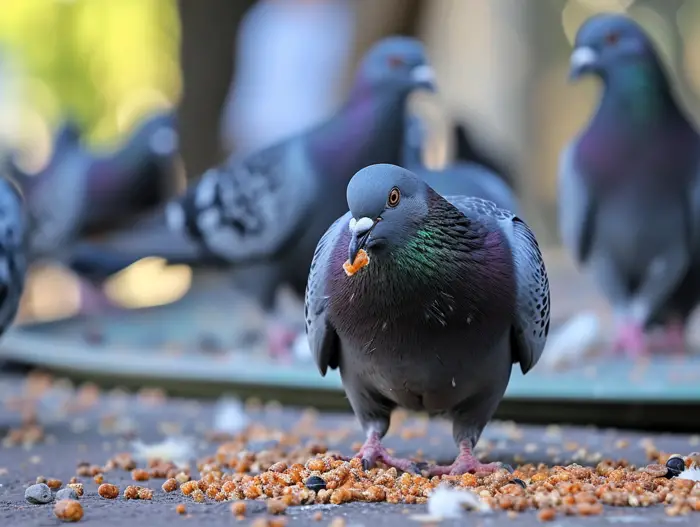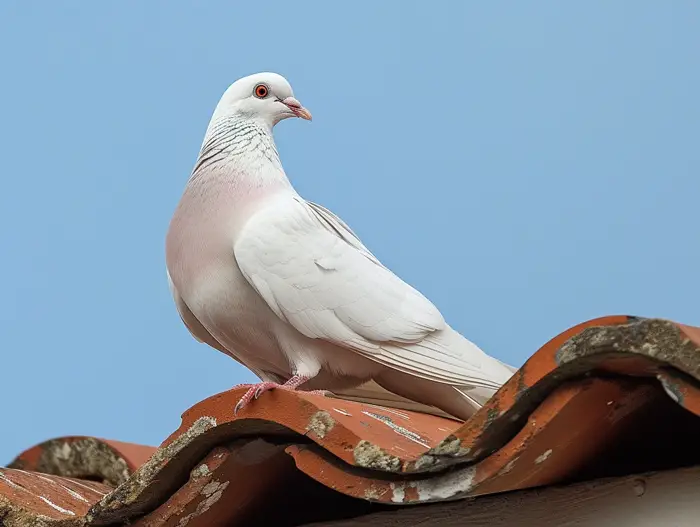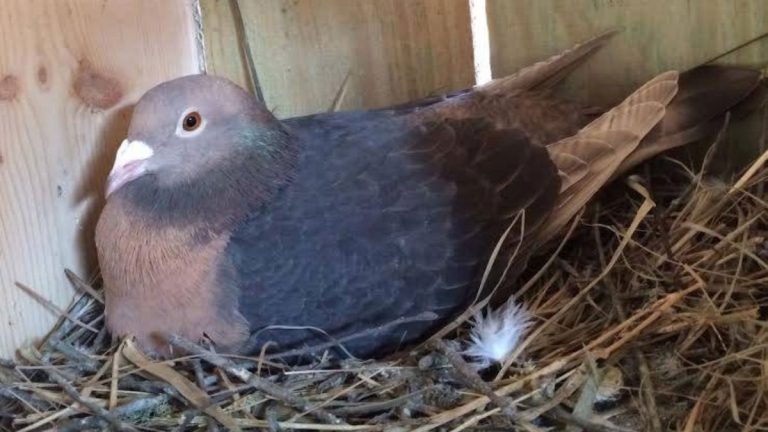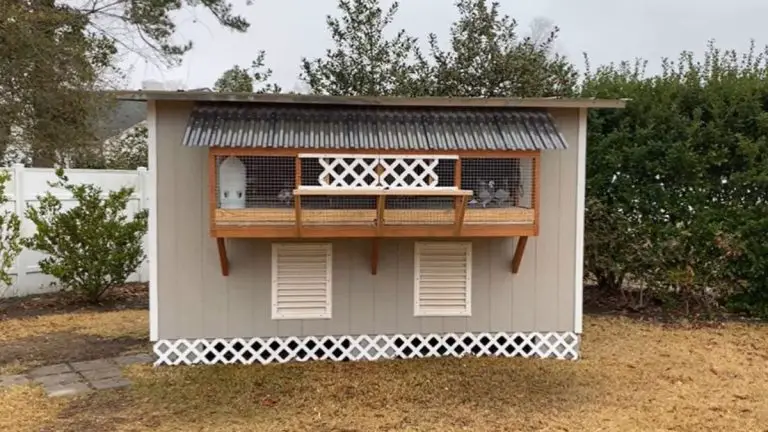Pigeon Behaviour Habits: Discover their Daily Routines
Pigeons, those ubiquitous birds that grace our city streets and park benches, have long fascinated me with their peculiar behaviors. From their distinctive cooing to their synchronized flight patterns, pigeons possess a unique set of habits that set them apart from other avian species. In this article, I’ll delve into the intriguing world of pigeon behavior, exploring their daily routines, social interactions, and instinctive habits. Whether you’re a curious observer or simply want to understand these feathered creatures better, join me as we unravel the secrets behind the habits of pigeons.
As creatures of habit, pigeons exhibit a remarkable consistency in their daily routines. From their early morning foraging to their evening roosting, pigeons follow a strict schedule that revolves around food, shelter, and social interactions. Understanding their habits can provide valuable insights into their survival strategies and help us appreciate their adaptability in urban environments. So, let’s take a closer look at the fascinating habits that govern the lives of these urban dwellers.
One of the most intriguing aspects of pigeon behavior is their social interactions. Pigeons are highly gregarious creatures, often found in large flocks that gather in public spaces. They engage in various forms of communication, such as cooing, head bobbing, and puffing up their feathers, to establish dominance, attract mates, and maintain social cohesion. By studying their social habits, we can gain a deeper understanding of their complex social structures and the role of hierarchy within pigeon communities. So, let’s embark on a journey into the captivating world of pigeon behavior and unravel the secrets behind their fascinating habits.
Daily Routines of Pigeons
As I observe the behaviors of pigeons, it becomes clear that they have specific routines that they follow each day. These daily habits are vital for their survival and overall well-being. Let’s take a closer look at the daily routines of these fascinating birds.

1. Roosting: Pigeons typically start their day by finding a safe roosting spot. They prefer elevated areas such as rooftops, ledges, or tree branches, where they can rest and stay clear of ground-level predators. This behavior helps them keep a watchful eye on their surroundings.
2. Feeding: Like any creature, pigeons need to eat to sustain themselves. They are opportunistic feeders and will scavenge for food in various urban environments. Whether it’s picking at discarded crumbs, searching for seeds, or foraging in parks, pigeons are resourceful when it comes to finding their next meal.
3. Watering: Staying hydrated is crucial for pigeons, and they make sure to find water sources throughout their day. Pigeons have a keen sense of finding water, whether it’s from puddles, fountains, or other sources. They will take a quick drink or even bathe to keep themselves clean and cool during warmer days.
4. Breeding: Pigeons are known for their strong instinct to breed, and it’s a significant part of their daily routine, especially during their breeding season. Males engage in elaborate courtship displays, puffing up their chests, cooing, and even strutting around to attract a mate. Once a pair forms a bond, they work together to build nests and incubate their eggs.
5. Socializing: Pigeons are highly social creatures and often found in large flocks. Interacting with other pigeons is an essential part of their routine. They communicate with each other through various vocalizations and body postures, establishing dominance, attracting mates, and maintaining social cohesion.
6. Resting and Preening: Throughout the day, pigeons take regular breaks to rest and groom themselves. Preening is an important part of their routine, as it helps them keep their feathers clean and well-maintained. By preening, pigeons also distribute natural oils across their feathers, which helps with insulation and waterproofing.
Foraging for Food
When it comes to finding food, pigeons have developed impressive skills. Their ability to scavenge and find sustenance in urban environments is truly remarkable. Let’s delve into their foraging habits and explore how they obtain their meals.

1. Scavengers of the City
Pigeons are highly adaptive creatures, making the most of their surroundings. They are opportunistic feeders, often seen pecking at scraps of food left behind by humans. Their keen eyesight helps them spot potential meals from a distance, and they waste no time in swooping down to gather their treasure.
2. Wide Variety of Food
One of the reasons why pigeons thrive in urban areas is their ability to consume a wide variety of food. They are not picky eaters and can feast on grains, seeds, fruits, vegetables, and even insects. This versatility allows them to adapt to different environments and find nourishment wherever they go.
3. Water Sources
Staying hydrated is crucial for pigeons, just like any other living being. They always keep an eye out for sources of water throughout the day. You might find them congregating near fountains, puddles, or even gutters to quench their thirst. Pigeons have a clever way of sipping water, using their beak to create a vacuum and drink it up.
4. Social Foraging
Pigeons are social creatures and often engage in group foraging. They communicate with each other and exchange information about food sources through a series of vocalizations and body postures. This cooperative behavior not only helps them locate food more efficiently but also strengthens their social bonds.
5. Efficient Digestive System
Pigeons have a remarkable digestive system that allows them to maximize the nutrients from their food. They possess a muscular pouch called a crop where the food is stored and softened before being gradually released into the stomach for digestion. This efficient process enables them to extract as many nutrients as possible from their meals.
As we can see, pigeons have adapted well to urban environments, making the most of available resources for their survival. Their scavenging skills, diverse diet, and social foraging habits contribute to their ability to thrive in both rural and urban areas.
Seeking Shelter and Roosting
Pigeons are fascinating creatures that have developed unique habits for seeking shelter and roosting. Let’s delve into these intriguing aspects of their behavior.

Roosting Patterns
Pigeons are known for roosting in large groups, creating a spectacle in urban environments. They have a natural tendency to flock together, seeking safety and companionship. You may have noticed pigeons gathering on rooftops, ledges, or trees at dusk as they prepare to settle for the night.
Preferred Roosting Spots
Pigeons have specific preferences when it comes to choosing their roosting spots. They typically favor elevated locations that offer protection from predators, such as buildings, bridges, and trees. These spots provide an advantageous vantage point for keeping an eye out for potential threats.
Benefits of Roosting Together
Roosting in groups serves several purposes for pigeons. First and foremost, it enhances their safety. By being part of a larger group, pigeons can collectively watch out for dangers, alerting each other to potential threats and increasing their chances of survival.
Additionally, roosting together helps pigeons conserve body heat during colder months. By huddling closely, they create a microclimate that offers warmth and shields them from chilly winds. This collective warmth is essential for their well-being during harsh weather conditions.
Roosting Behavior
Pigeons exhibit interesting roosting behavior. When they arrive at their chosen roosting spot, they may engage in activities such as preening their feathers, socializing with other pigeons, or engaging in courtship displays. These behaviors strengthen social bonds within the flock and ensure their overall well-being.
Urban Roosting Challenges
While pigeons have adapted well to urban environments, they face certain challenges when it comes to roosting. Urban structures, such as buildings and warehouses, can limit access to suitable roosting spots. This forces pigeons to find alternative locations, which may not always provide the same level of safety or comfort.
In Summary
Pigeons’ roosting behaviors reflect their natural instincts for safety, warmth, and social interaction. Roosting in groups enables them to protect each other, stay warm, and form strong social bonds. Despite the challenges posed by urban environments, pigeons have found ways to adapt and make the most of available roosting spots.
Social Interactions and Communication
As I continue to explore the fascinating habits of pigeons, I can’t help but be intrigued by their social interactions and communication. These birds are not only skilled navigators and foragers, but they also possess a complex system of communication that allows them to interact with each other.
Pigeons are highly social creatures, often found in large flocks or groups. Within these groups, they engage in various types of social behaviors that contribute to their survival and overall well-being.
Social Interactions:
- Preening: Pigeons spend a considerable amount of time preening their feathers. This behavior not only helps them maintain their plumage in optimal condition but also serves as a bonding activity among group members.
- Nest Building: Pigeons build nests together, with both males and females contributing to the construction process. This collaborative effort strengthens social bonds and ensures successful breeding.
- Parenting: Pigeon parents take turns incubating the eggs and caring for the young. They display nurturing behaviors, such as feeding and protecting their offspring. This cooperative parenting enhances the survival rate of the chicks.
- Feeding Frenzy: When pigeons find a food source, they communicate its location to other flock members through a combination of vocalizations and body language. This initiates a feeding frenzy, with pigeons rushing to the spot to share in the abundance.

Communication:
- Vocalizations: Pigeons communicate through a wide range of sounds, such as cooing, clucking, and even hissing. Each vocalization conveys different messages, including territorial defense, mating calls, and alarm signals.
- Body Language: Pigeons also utilize body language to communicate with each other. They puff up their chests to display dominance, bob their heads in recognition or courtship, and engage in various wing movements during territorial disputes.
- Homing Instinct: Pigeons’ incredible homing instinct is another form of communication. They possess the ability to navigate vast distances and return to their roosting site, sending a signal to their flock members about the availability of resources and safety.
Establishing Dominance and Attracting Mates
As we delve deeper into the fascinating world of pigeon behavior, we uncover a myriad of intriguing habits and instincts that shape their daily lives. One such aspect is the establishment of dominance within the flock, which plays a crucial role in the mating game.
Dominance Hierarchy
Pigeons are highly social creatures, and within their flocks, a hierarchical structure exists. In this pecking order, certain individuals assert dominance while others submit, creating a harmonious balance within the group. The dominant pigeons enjoy certain privileges such as access to the best roosting spots and first pickings at feeding time.
Displaying Dominance
How do pigeons establish their dominance? They engage in a variety of behaviors to assert their position. One common display is puffing up their chests and fanning out their tails, making themselves appear larger and more imposing. This physical display serves as a clear signal to others that they should be respected and defer to their authority.
Courting and Mating Behavior
Dominance is not only important for establishing social order; it also plays a significant role in attracting mates. Pigeons engage in elaborate courtship rituals to impress potential partners. The dominant males perform impressive displays of cooing, bowing, and puffing out their chests to catch the attention of nearby females.
Choosing a Mate
To attract a mate, pigeons rely on their impressive displays of dominance, as well as other factors. Females are known to seek out healthy and strong males, as they provide an increased chance of survival for their offspring. Similarly, males are drawn to females that exhibit desirable traits such as vibrant feather colors and physical fitness.
As we explore the habits of pigeons, it becomes evident that establishing dominance and attracting mates are crucial aspects of their behavior. These behaviors contribute to the social harmony and reproductive success of the flock. By understanding the intricacies of pigeon behavior, we gain a deeper appreciation for these remarkable creatures.
Whether it is asserting dominance or engaging in elaborate courtship rituals, pigeons exhibit a fascinating array of behaviors that enhance their survival and perpetuation of their species. Their habits continue to captivate researchers and enthusiasts alike, as we uncover the intricacies of their daily lives.
Conclusion
In this article, we have explored the fascinating habits and behaviors of pigeons. From their foraging routines to their preferred roosting spots, we have gained insight into the daily lives of these remarkable birds. We have also delved into their social interactions and communication methods, discovering how they use vocalizations, body language, and their innate homing instinct to connect with one another.
By understanding the establishment of dominance within pigeon flocks, we have learned how this plays a crucial role in attracting mates. Pigeons engage in various behaviors, such as puffing up their chests and fanning out their tails, to assert their dominance and catch the attention of potential partners. The choice of a mate is influenced by factors such as health, strength, and desirable traits, highlighting the importance of these behaviors in the pigeon world.
Through this exploration, we have gained a deeper appreciation for the complexity and beauty of pigeon behavior. Their ability to adapt, communicate, and form social bonds showcases their remarkable lives. By observing and understanding these habits, we can continue to learn and marvel at the wonders of the natural world.






